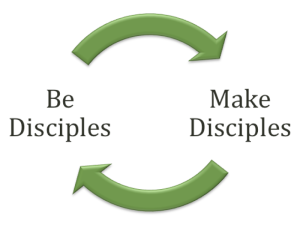I teach a Sunday school class at my church, and I’m asking myself the question, “Am I really making  disciples through my ministry as a teacher?” This question has haunted me lately. I don’t want to be “that guy” who teaches my group members lots of interesting facts and factoids so I can hear them “ooh” and “aahh” when I tell them something they’ve not previously heard. I want to be obedient to Jesus’ command to “go and make disciples.” How about you?
disciples through my ministry as a teacher?” This question has haunted me lately. I don’t want to be “that guy” who teaches my group members lots of interesting facts and factoids so I can hear them “ooh” and “aahh” when I tell them something they’ve not previously heard. I want to be obedient to Jesus’ command to “go and make disciples.” How about you?
It is my observation that in some places, Sunday School has morphed into an information-dispensing ministry. While I know that people need information about the Bible, that cannot be the end game. The real goal of Sunday school is to make disciples. Disciples follow. Disciples sacrifice. Disciples obey. Disciples are committed. Disciples are unwavering. Disciples are life-long learners. Disciples lead. Disciples grow…sometimes beyond their teacher. Does this describe the average person in your group? In your Sunday school? If not, perhaps it’s time to re-think why your Sunday School, or your group, exists.
Robby Gallaty, pastor and author of Growing Up: How to Make Disciples Who Make Disciples, says in that book, “When the church becomes an end in itself, it ends. When Sunday school, as great as it is, becomes an end in itself, it ends. When small groups ministry becomes an end in itself, it ends. When the worship service becomes an end in itself, it ends. What we need is for discipleship to become the goal, and then the process never ends. The process is fluid. It is moving. It is active. It is a living thing. It must continue to go on. Every disciple must make disciples.” To make disciples through a Sunday school ministry, at least three things need to happen, probably more, but these are at least a starting point for creating disciples through your Sunday school ministry:
- Groups must get smaller – Discipleship happens when small groups of people come together. Jesus’ model seems to be two primary groups: (1) a group of 3 (often referred to as “His inner circle” of disciples), and (2) the twelve disciples. It is true He sometimes spoke to very large crowds (Sermon on the Mount, in the temple courtyards, etc), but his normal way to make disciples was to do so in small groups. This has the advantage of allowing the teacher to know his learners and what each one needs to grow and progress in becoming more Christ-like.
- Teachers must stop talking – Disciple-making teachers know that people they teach need to be allowed to talk, and encouraged to talk, at least as much as they do. For some teachers, this is counter-intuitive. Somewhere along the way, many teachers have adopted a mentality that says, “I’m the expert, and you’re not – so listen to what I have to say.” It’s true that teachers often study for many hours in preparation to teach their group members – and that is highly commendable and appropriate. But what is truly effective in a learning setting is when teachers becomes guides and lead their people to discuss deep truths, wrestle with things presented in Scripture, and challenge assumptions and actions. Ed Stetzer, VP at LifeWay and leader of LifeWay Research, has said that every Bible study should be a “groupalogue.” By that he meant that each person in a Bible study group should be allowed to talk, and even encouraged to talk. Without that, the class ends up being a place in which a monologue takes place weekly (the teacher simply becomes the talking head).
- Churches must answer the “why” question – Before discipleship can take place through the Sunday school, it is helpful and necessary for church leaders, group leaders, and group members to wrestle with the reason Sunday School exists in the first place. Fellowship, Bible study, ministry, and outreach are all part of what Sunday school seeks to accomplish, but they are not and end in themselves. The real goal of Sunday school should be to see disciples made – that’s really why Sunday School exists in the first place. We must constantly be on guard for “discipleship drift.”
Jim Putnam, in his book DiscipleShift: 5 Steps That Help Your Church To Make Disciples, says, “The vision is that the church’s primary mission is to create disciples who create other disciples, just as Jesus intended us to do. It’s helping people see that the church isn’t a social club, it’s not a hospital, it’s not a university, and it’s not a big show. The church is a community that is developing people who follow Jesus, are changed by Jesus, and then join Jesus on his mission.”
Help your church take Sunday school to a different level entirely as a place where discipleship occurs. It’s past time to make the main thing the main thing again.
____________________________________
Like what you’re reading? Sign up for daily posts Monday-Friday. Click here to jump to the home page of kenbraddy.com. Sign up with just your email address in the right sidebar menu. Your email is never sold. Unsubscribe at any time.